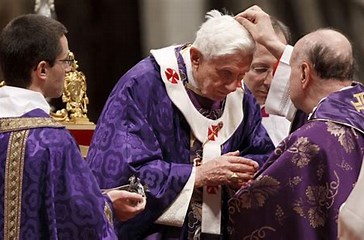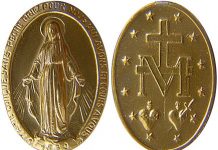BENEDICT XVI
GENERAL AUDIENCE
Paul VI Audience Hall
Wednesday, 9 March 2011
Ash Wednesday
Dear Brothers and Sisters,
On this day, marked by the austere symbol of ashes, we enter the Season of Lent, beginning a spiritual journey that prepares us for celebrating worthily the Easter Mysteries. The blessed ashes imposed upon our forehead are a sign that reminds us of our condition as creatures, that invites us to repent, and to intensify our commitment to convert, to follow the Lord ever more closely.
Lent is a journey, it means accompanying Jesus who goes up to Jerusalem, the place of the fulfilment of his mystery of Passion, death and Resurrection; it reminds us that Christian life is a “way” to take, not so much consistent with a law to observe as with the very Person of Christ, to encounter, to welcome, to follow.
Indeed, Jesus says to us: “If any man would come after me, let him deny himself and take up his cross daily and follow me” (Lk 9:23). In other words he tells us that in order to attain, with him, the light and joy of the Resurrection, the victory of life, of love and of goodness, we too must take up our daily cross, as a beautiful passage from the Imitation of Christ urges us: “Take up your cross, therefore, and follow Jesus, and you shall enter eternal life. He himself opened the way before you in carrying his Cross (Jn 19:17), and upon it he died for you, that you too, might take up your cross and long to die upon it. If you die with him, you shall also live with him, and if you share his suffering, you shall also share his glory” (Book 2, chapter 12, n. 2).
In Holy Mass of the First Sunday of Lent we shall pray: “Father, through our observance of Lent, sign of the sacrament of our conversion, help us to understand the meaning of your Son’s death and Resurrection, and teach us to reflect it in our lives” (Opening Prayer).
This is an invocation that we address to God because we know that he alone can convert our hearts. And it is above all in the Liturgy, by participating in the holy mysteries, that we are led to make this journey with the Lord; it means learning at the school of Jesus, reviewing the events that brought salvation to us but not as a mere commemoration, a remembrance of past events. In the liturgical actions Christ makes himself present through the power of the Holy Spirit and these saving events become real.
There is a keyword that recurs frequently in the Liturgy to indicate this: the word “today”; and it should be understood in its original and practical, rather than metaphorical, sense. Today God reveals his law and we are granted to choose today between good and evil, between life and death (cf. Dt 30:19). Today “the Kingdom of God is at hand; repent and believe in the Gospel” (Mk 1:15). Today Christ died on Calvary and rose from the dead; he ascended into Heaven and is seated at the right hand of the Father; today the Holy Spirit is given to us; today is a favourable time.
Taking part in the Liturgy thus means immersing our life in the mystery of Christ, in his enduring presence so as to follow a path on which we enter his death and Resurrection in order to have life. The Sundays of Lent, in this liturgical year of Cycle A in a quite particular way, introduce us to the experience of a baptismal journey, almost as if we were retracing the path of the catechumens, of those who are preparing to receive Baptism, in order to rekindle this gift within us and to ensure that our life may recover a sense of the demands and commitments of this sacrament which is at the root of our Christian life.
In the Message for this Lent I wished to recall the particular connection that binds Baptism to the Season of Lent. The Church has always associated the Easter Vigil with the celebration of Baptism, step by step. In it is brought about that great mystery through which man, dead to sin, is enabled to share in new life in the Risen Christ and receives the Spirit of God who raised Jesus from the dead (cf. Rom 8:11).
The Readings we shall listen to on the coming Sundays and to which I ask you to pay special attention are taken up precisely by the ancient tradition which accompanied catechumens in the discovery of Baptism. These Readings are the great proclamation of what God brings about in this sacrament, a wonderful baptismal catechesis addressed to each one of us.
The First Sunday of Lent, known as the “Sunday of the Temptation” because it presents Jesus’ temptations in the wilderness, invites us to renew our definitive adherence to God and, in order to remain faithful to him, to face courageously the struggle that awaits us.
Over and over again we need determination, resistance to evil, we need to follow Jesus. On this Sunday, after hearing the testimony of the godparents and catechists, the Church celebrates the election of those who are admitted to the Easter sacraments.
The Second Sunday is called “of Abraham and of the Transfiguration”. Baptism is the sacrament of faith and of divine sonship; like Abraham, Father of believers, we too are asked to set out, to depart from our land, to give up the security we have created for ourselves in order to place our trust in God; the destination is glimpsed in the Transfiguration of Christ, the beloved Son, in whom we too become “sons of God”.
On the following Sundays, Baptism is presented in images of water, light and life. The Third Sunday makes us meet the Samaritan woman (cf. Jn 4:5-42). Like Israel in the Exodus, in Baptism we too have received the water that saves; Jesus, as the Samaritan woman says, has living water that quenches all thirst; and this water is the Spirit himself. On this Sunday the Church celebrates the First Scrutiny of the catechumens and during the week presents to them the Creed: the profession of faith.
(To continue reading, please see here)











